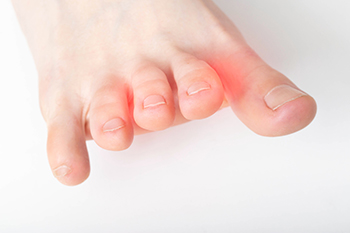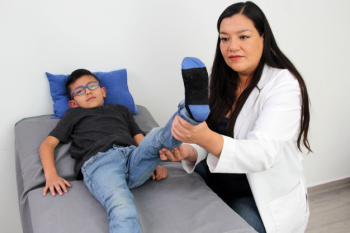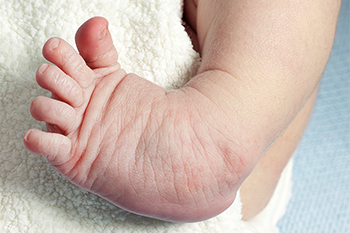

A neuroma is a thickening of nerve tissue caused by irritation, compression, or trauma. The most common type is Morton’s neuroma, which affects the nerve between the third and fourth toes. This condition develops when the nerve becomes inflamed due to repetitive stress, wearing tight footwear, or biomechanical issues, leading to pain, tingling, or a sensation of walking on a pebble. Over time, an untreated neuroma can worsen, causing chronic pain and permanent nerve damage. The affected nerve may continue to enlarge, making non-surgical treatments less effective. A podiatrist can provide relief through custom orthotics, footwear modifications, corticosteroid injections, or minimally invasive procedures. In severe cases, surgical removal of the neuroma may be necessary. If you think you have a foot neuroma, it is suggested that you schedule an appointment with a podiatrist for a proper diagnosis and appropriate treatment.
Morton’s neuroma is a very uncomfortable condition to live with. If you think you have Morton’s neuroma, contact Dr. Robert Hope of Riverside Podiatry. Our doctor will attend to all of your foot care needs and answer any of your related questions.
Morton’s Neuroma
Morton's neuroma is a painful foot condition that commonly affects the areas between the second and third or third and fourth toe, although other areas of the foot are also susceptible. Morton’s neuroma is caused by an inflamed nerve in the foot that is being squeezed and aggravated by surrounding bones.
What Increases the Chances of Having Morton’s Neuroma?
Morton’s neuroma is a very treatable condition. Orthotics and shoe inserts can often be used to alleviate the pain on the forefront of the feet. In more severe cases, corticosteroids can also be prescribed. In order to figure out the best treatment for your neuroma, it’s recommended to seek the care of a podiatrist who can diagnose your condition and provide different treatment options.
If you have any questions, please feel free to contact our office located in Tuscaloosa, AL . We offer the newest diagnostic and treatment technologies for all your foot care needs.

Foot problems in children are more common than many parents realize, and addressing them early can prevent long-term problems. One of the most common issues is toeing, where a child may walk with their toes pointed inward, known as in-toeing, or outward, referred to as out-toeing. Both conditions are typically caused by alignment issues but may resolve with time. Athlete's foot is another frequent issue, caused by fungal infections that can lead to itching, redness, and peeling skin. Ankle sprains are common in active children and occur when the ligaments in the ankle stretch or tear during physical activities. Ingrown toenails, which form when the edges of nails grow into the skin, can be painful and lead to infections. Additionally, plantar warts, caused by a viral infection, can also affect children’s feet, causing growths on the soles. If your child has foot pain, it is suggested that you consult a podiatrist who can treat various foot conditions.
The health of a child’s feet is vital to their overall well-being. If you have any questions regarding foot health, contact Dr. Robert Hope of Riverside Podiatry. Our doctor can provide the care you need to keep you pain-free and on your feet.
Tips for Keeping Children's Feet Healthy
If you have any questions, please feel free to contact our office located in Tuscaloosa, AL . We offer the newest diagnostic and treatment technologies for all your foot care needs.

Clubfoot, or talipes equinovarus, is a congenital condition where a baby’s foot turns downward and inward, often affecting the alignment and mobility of the foot and ankle. In true clubfoot, structural abnormalities in the bones or underdevelopment of the calf muscles are present. In positional clubfoot, this condition is the result of how the baby was positioned in the womb. Other congenital foot deformities include metatarsus adductus, where the foot turns inward and joint mobility may be limited, and metatarsus varus, which causes the foot’s bottom surface to turn inward, raising the arch. Talipes calcaneovalgus presents with a backward-bent foot and outward-facing heel. These congenital abnormalities can affect a child’s ability to bear weight and walk as they grow. A podiatrist can assess the severity of these conditions and recommend corrective casting, bracing, or surgery, if needed. If your child is born with a foot abnormality, it is suggested that you schedule an appointment with a podiatrist for a diagnosis and treatment options.
Congenital foot problems require immediate attention to avoid future complications. If you have any concerns, contact Dr. Robert Hope of Riverside Podiatry. Our doctor can provide the care you need to keep you pain-free and on your feet.
Congenital foot problems are deformities affecting the feet, toes, and/or ankles that children are born with. Some of these conditions have a genetic cause while others just happen. Some specific foot ailments that children may be born with include clubfeet, polydactyly/macrodactyly, and cleft foot. There are several other foot anomalies that can occur congenitally. What all of these conditions have in common is that a child may experience difficulty walking or performing everyday activities, as well as trouble finding footwear that fits their foot deformity. Some of these conditions are more serious than others. Consulting with a podiatrist as early as possible will help in properly diagnosing a child’s foot condition while getting the necessary treatment underway.
What are Causes of Congenital Foot Problem?
A congenital foot problem is one that happens to a child at birth. These conditions can be caused by a genetic predisposition, developmental or positional abnormalities during gestation, or with no known cause.
What are Symptoms of Congenital Foot Problems?
Symptoms vary by the congenital condition. Symptoms may consist of the following:
Treatment and Prevention
While there is nothing one can do to prevent congenital foot problems, raising awareness and receiving neonatal screenings are important. Early detection by taking your child to a podiatrist leads to the best outcome possible.
If you have any questions please feel free to contact our office located in Tuscaloosa, AL . We offer the newest diagnostic tools and technology to treat your foot and ankle needs.

Rheumatoid arthritis, or RA, and osteoarthritis, OA, both affect the joints of the feet, toes, and ankles, but are distinct in their causes and progression. RA is a disorder where the immune system attacks the lining of the joints, leading to inflammation, pain, and stiffness that can affect both feet symmetrically. Over time, this can result in joint deformities and decreased mobility. OA is a degenerative condition caused by the breakdown of cartilage, leading to bones rubbing against each other. This wear and tear often results in extreme pain, swelling, and the development of bony growths, which may affect one foot more than the other. Risk factors for RA include family history and being female, while OA is more common with age, obesity, or previous joint injuries. A podiatrist can manage arthritis in the feet, by determining the type of arthritis, recommending appropriate footwear, and suggesting options to reduce pain and preserve joint function. If you have foot problems resulting from arthritis, it is suggested that you schedule an appointment with a podiatrist for a diagnosis and treatment.
Because RA affects more than just your joints, including the joints in your feet and ankles, it is important to seek early diagnosis from your podiatrist if you feel like the pain in your feet might be caused by RA. For more information, contact Dr. Robert Hope of Riverside Podiatry. Our doctor will assist you with all of your podiatric concerns.
What Is Rheumatoid Arthritis?
Rheumatoid Arthritis (RA) is an autoimmune disorder in which the body’s own immune system attacks the membranes surrounding the joints. Inflammation of the lining and eventually the destruction of the joint’s cartilage and bone occur, causing severe pain and immobility.
Rheumatoid Arthritis of the Feet
Although RA usually attacks multiple bones and joints throughout the entire body, almost 90 percent of cases result in pain in the foot or ankle area.
Symptoms
Diagnosis
Quick diagnosis of RA in the feet is important so that the podiatrist can treat the area effectively. Your doctor will ask you about your medical history, occupation, and lifestyle to determine the origin of the condition. Rheumatoid Factor tests help to determine if someone is affected by the disease.
If you have any questions please feel free to contact our office located in Tuscaloosa, AL . We offer the newest diagnostic and treatment technologies for all your foot and ankle needs.